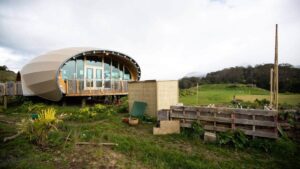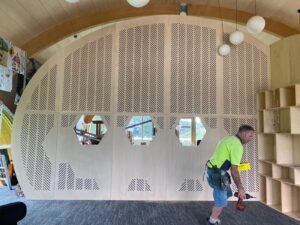Case Study
Green School x SonoLayr Technology
February 1, 2022
Customer Success Story
Green School is designed to inspire the next generation with life and nature. There is something to discover everywhere you look, with purposeful and meaningful architectural design to enable better learning and education.
As with a lot of commercial spaces that are designed for many people to enjoy, whether it be a working or recreational space, noise is often a problem that has to be managed
With the design of the Weka classroom, the challenge was to find an acoustic solution that separated the open timber-lined space into two separate classrooms, minimising noise transfer without fully closing them off from one another or losing the warmth and beauty of the timber in the space.
 Weka classroom at Green School New Zealand
Weka classroom at Green School New Zealand
Finding a solution that would reduce the noise between and within the classrooms and children without closing off the two spaces proved difficult. Although large spaces with high ceilings are beautiful, they amplify sound travelling across the space especially with hard surfaces to bounce off. SonoLayr, our nanofibre sound absorption media, was the perfect solution.
SonoLayr is made from electrospun nanofibres that form the worlds densest yet lightest functional textiles. Its dense web of nanofibres has an incredibly high surface area for sound absorption but its lightweight, almost negligible weight, makes use and application extremely easy.
“At Green School we go the extra mile with design, we pursue beauty and what we found with SonoLayr is that it doesn’t interrupt that process and can be part of it” – Mike Perrett, Green School Co-Founder
 Laser cut wooden room barrier integrated with SonoLayr
Laser cut wooden room barrier integrated with SonoLayr
Because SonoLayr is so thin, it was easily integrated into the Weka Classrooms building structure, unlike large blankets of absorbent material that would have to cover the natural timber surfaces.
Inspired by nature and a different way of thinking, SonoLayr was installed in the wooden division panel without compromising the beauty, flow and design of the space.
Ambient sound can be both distracting and uncomfortable at excessive levels. Conventional methods of acoustic control, including foams and fabrics, are used to absorb, reflect and diffuse sound, but do come with increased thickness and weight to the end area. SonoLayr redefines acoustic solutions that are typically found in the market by being lightweight, thin and yet highly effective.
“For designers looking for solutions to acoustic absorbency, definitely look at SonoLayr as a material it’s got some great applications and very easy to work with.” – Glenn Brebner, Director of BOON Team Architects